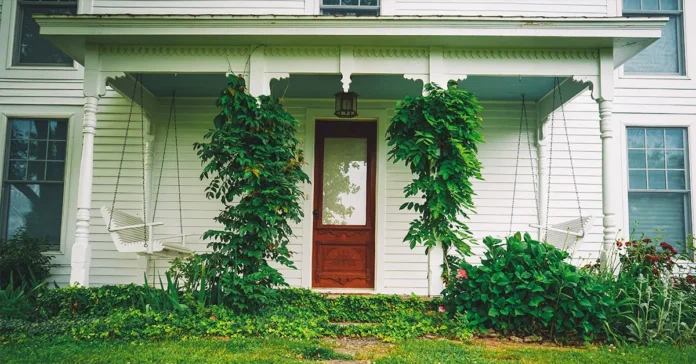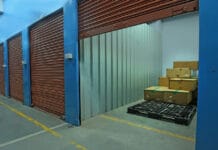Decluttering your outdoor space can be just as important as organizing your indoor areas. Whether you’re preparing for a renovation or simply looking to refresh your yard, effective outdoor cleaning techniques can make a big difference. Start by evaluating your space and determining what items need to be kept, donated, or discarded. Use box storage to neatly organize tools, gardening supplies, and other outdoor essentials. This will not only help you keep your space tidy but also ensure that everything is easily accessible.
Consider investing in a storage facility or outdoor shed to house items that are used infrequently but still necessary. Regularly cleaning and decluttering will prevent clutter from piling up and keep your outdoor area looking its best. Focus on clearing debris, organizing furniture, and maintaining your garden to create a welcoming environment. With these simple strategies, you can efficiently manage your outdoor space and enjoy a clutter-free, functional area for relaxation and enjoyment.
Outdoor Cleaning Strategies – Reasons for Decluttering
When you think about decluttering your home, do not forget to step outdoors and have a look around the front yard and backyard. It is just as important to keep the space around your home tidy and free of clutter as it is to the rooms within.
Why is decluttering the outdoor space important? Let us look at some important reasons:
1. To make your home look more welcoming.
This applies to you as much as to guests. The front entrance of your home gives away the first impression to your guests. Stepping into an overgrown yard or a veranda strewn with toys and tools and other unidentifiable objects is not the desirable impression.
2. To give you a clean space to enjoy some fresh air.
Being able to sit on your patio or balcony and sip on a hot beverage on a cool summer evening is a must-do activity for anyone with a patio or balcony. If you must pick your way through a maze of clutter to find a chair to sit on, that is no fun at all.
3. To give you a delightful place to entertain.
Dining under the stars or letting the kids have a picnic in the garden is one of the great advantages of having a house with a yard. It is a welcome break from the monotony of sitting indoors. With some simple seating arrangements and warm lighting, your patio will be a wonderful zone to entertain a small gathering.
4. To add a dash of green to your life and the community.
You can replace the clutter around your house with grass, flower beds, and potted plants. Gardening is one of the most calming and rewarding hobbies; and of course, you will be creating a clean green footprint on the environment.
5. To prevent rodent trouble.
When you have a pile of trash, you can be sure that a mouse or two will find its way in there and make a home for itself. A build-up of dust, grime, and moisture make the place even more welcoming for creepy crawlies. Then it is only a matter of time before you have a bug infestation at home.
6. To make a great sale.
In case you are thinking of moving to another home and want to sell your current place, decluttering your yard can really make a good impression. It will give potential buyers an idea of how much space is available around the house to work with. If you put some extra work into furnishing the deck with seating, cabinets, and a dining area, it will entice prospective buyers.
Steps to decluttering your outdoor spaces
You do not need to have a sprawling garden or a 1-kilometer-long driveway to consider the space around your house worth maintaining. That said the more space, the better care you need to give it.
In the name of decluttering their homes, most people tend to neglect the veranda, balcony, backyard, and garage. Some even take excess goods from indoors and pile them up unceremoniously in these outside spaces as a quick fix to cleaning out the inside spaces. From broken furniture to unused gym equipment and toys the kids have outgrown, anything that is not required anymore is pushed into a corner of the patio or yard and forgotten about. Over time the spot becomes a magnet for junk, and you have a mound of things cramping what could have been a beautiful outdoor dining area.
So, here is your step-by-step guide on how to declutter a messy outdoor space.
Step 1: Group the Related Items.
An effective way to get started on decluttering your outdoor spaces is by grouping things according to specific categories such as gardening tools, kitchen/ dining accessories, furniture, sports equipment, camping gear, cleaning supplies, etc. Make a pile of miscellaneous items that do not fit into any specific category.
Step 2: Sort through each group.
Once you have made distinctive piles of all the items lying around, it is time for some tough decisions. Assess the value of every single item based on functionality and sentimental attachment, and not just on how expensive each one is. All things that are broken and beyond repair need to go in the trash or scrap. Items of sentimental value but no other use, can either be donated to someone or put into storage. If you have not used something for more than six months, you do not need it. Make practical choices.
Somewhere between the things you need and the junk, are items that are of no practical use but of immense sentimental value. You may not want to keep it on display, but you may not want to throw it away either. These sentimental possessions can be securely stored in a self-storage unit. Renting out a storage room gives you the option of stowing away large pieces of furniture, seasonal decor, and anything that you use rarely.
Step 3: Set up outdoor storage.
Once you have decided which of your belongings you are keeping, you need to figure out where you are going to keep them.
- Cordon off a small space in your backyard or garage for storage.
- If possible, construct a small shed with shelves.
- In case you do not have room to build a shelf, put up a partition or a screen
- If you have a garage, add wall shelves for extra storage.
- Invest in patio furniture with built-in storage for toys, cutlery, rugs, and other items you may need when you spend time outdoors.
- Create a gardening station to put away tools, extra pots, bags of soil, fertilizers, etc.
- Use storage containers to keep small objects organised.
- Items that you use seasonally such as swimming gear, camp equipment, and outdoor grills must be cleaned, dried, and put into storage.
Step 4: Organise items chosen to keep.
Taking everything that you have decided to keep and putting them in a shed or the garage, will clear up your outdoor spaces. Nevertheless, you need to store them in such a way that they are easily accessible. When you just pile them on each other it is difficult to find items when you need them. Furthermore, keep safety in mind. Tall piles can topple over creating a bigger mess for you to clear. Heavy equipment can get damaged unless weatherproofed. To avoid these problems, you need to organise your goods properly.
- Wall shelves are practical and highly efficient. You can place storage containers, small potted plants, and even decorative artefacts on them.
- A shed with shelves is a great solution for outdoor storage. The shed protects your items from the elements and the shelves help you organise your items efficiently.
- A bench with storage space is a value-add because not only does it allow you to store items in it, but also becomes part of the seating arrangement.
- Hanging Hooks are space savers and can be used to hang garden tools such as shovels, rakes, shears, etc.
- A Stand-alone shelving cabinet is also quite handy to organise your items in case you cannot construct a shed.
Step 5: Invest in the right furniture.
The furniture that you set up in your outdoor space must be durable and capable of withstanding heat and rain. It will help more if the furniture has inbuilt storage space. Keep the following in mind when picking your outdoor furniture:
– Get a deck box that can hold patio furniture cushions and throw blankets.
– Install ample seating. Without cramping the space, add as many seats as possible. Chairs, sofas, benches, ottomans, stools, poufs, etc.
– You can get stackable chairs or foldable ones, which are easy to store after use.
– If you have a small patio, install a wall table that can be folded when not in use, or pick a small coffee table.
– A small cabinet can be used to store any dining cutlery that may be required while entertaining guests. It can also be used to store miscellaneous items from tools to toys.
Step 6: Revamp your Outdoor Space.
Having gotten rid of all the junk and found ways to store the items you need; you will see how clean and spacious your outdoors become. As the final touch of decluttering you can set the mood and ambiance of the space with the help of some small tweaks.
– Do not overcrowd the space with furniture. Optimise the furniture for a spacious look on the patio.
– Lighting is especially important to set the mood. A small string of fairy lights is all it takes to spruce up the place. A small chandelier or a tall floor lamp will add a touch of class as well.
– Rugs, cushions, and throw blankets make the space look even more cozy and comfortable.
– Plant stands lined with potted plants make you feel one with nature.
– If you have a large space to work with, you can define separate spaces for different activities. For example, a barbeque zone, a dining zone for adults and one for kids, and an open bar.
Step 7: Maintain your Outdoor Living Space.
Appreciate the beauty of the new space you have created and the effort put into it. After you have decluttered and styled your outdoor space, step back and appreciate the difference.
Once you have decluttered your home make sure that you maintain the space that way. Do not allow exposed surfaces to accumulate unwanted dust or stray items. Make sure you put things away in their designated places. It helps if you assign places to objects based on how frequently you use them. Make time once a week to declutter.
Conclusion for Outdoor Cleaning
In conclusion, simplifying your outdoor space through effective cleaning and decluttering techniques can significantly enhance its functionality and appearance. By using box storage to organize tools and supplies, and considering a storage facility for larger items, you can keep your yard neat and accessible. Regular maintenance, including clearing debris and tidying up your garden, ensures that your outdoor area remains inviting and practical.
Whether you’re preparing for a renovation or just looking to enjoy a clutter-free environment, these strategies will help you achieve a well-organized space. Consistent effort in outdoor cleaning and decluttering not only improves the aesthetics of your yard but also creates a more enjoyable and stress-free outdoor living area.
FAQs
A1: Begin by assessing your outdoor space and sorting items into keep, donate, or discard categories. Clear debris, clean surfaces, and organize items into boxes or storage solutions.
A2: Box storage helps keep small tools, gardening supplies, and seasonal items organized and easily accessible. Labeling boxes makes it easier to find what you need quickly.
A3: Outdoor sheds, storage benches, and weather-resistant boxes are ideal for keeping items protected and organized.
A4: Regular cleaning and decluttering should be done seasonally or at least twice a year to prevent clutter from accumulating and maintain a tidy space.
A5: For large items, consider using a storage facility or outdoor shed. If possible, disassemble or stack items to maximize space and keep them organized.
A6: Use a rake or broom to gather leaves and debris. For larger items, a leaf blower or vacuum can speed up the process, making cleanup quicker and easier.
A7: Yes, using outdoor cleaning products can help remove dirt, stains, and grime from surfaces like patios and furniture. Choose products that are suitable for the materials you are cleaning.
A8: Regularly trim plants, remove weeds, and clean garden tools. Use garden storage solutions to keep tools and supplies organized and out of sight.
A9: Arrange furniture in a way that maximizes space and accessibility. Use outdoor storage covers or sheds to protect furniture from the elements when not in use.
A10: Break tasks into manageable steps and set aside specific times for cleaning and decluttering.








